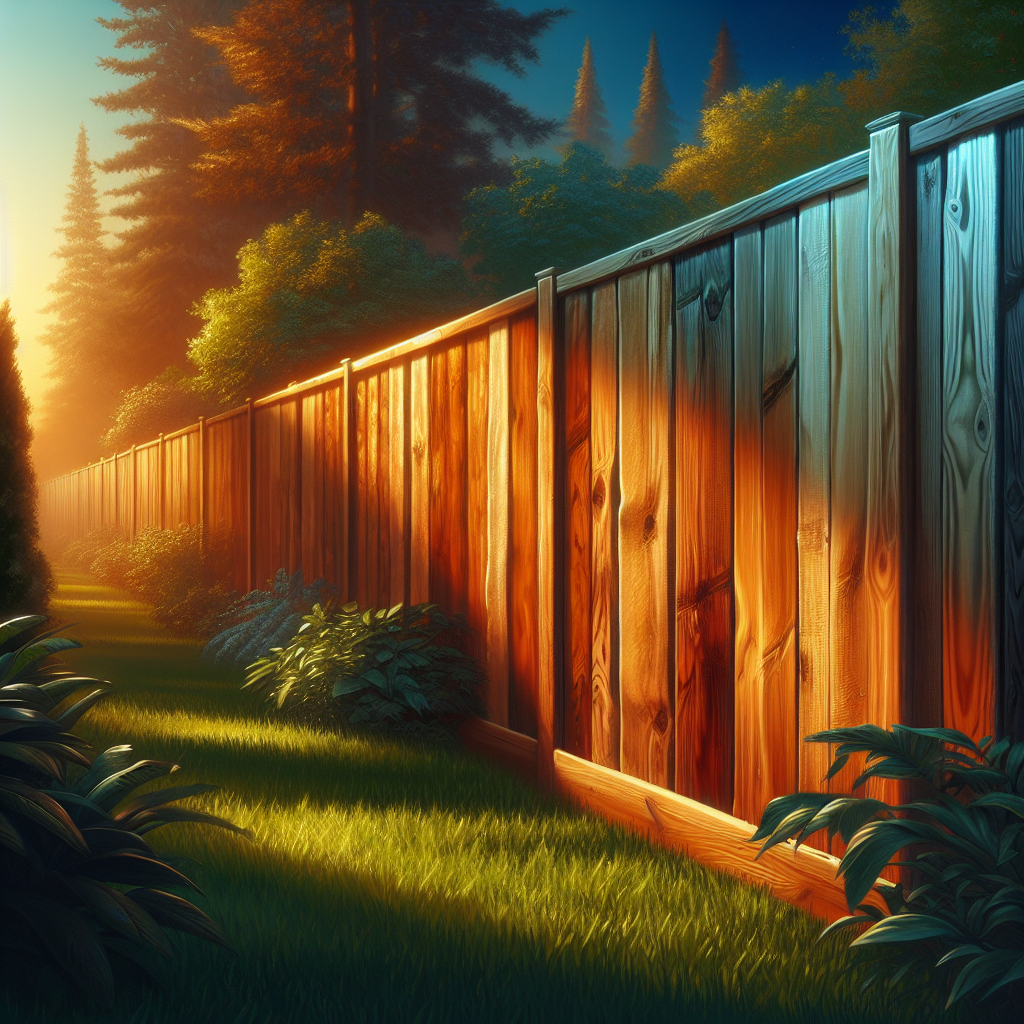You want to install a wooden privacy fence in your backyard, but you’re not sure how long it will actually last. Well, you’re in luck! In this article, we’re going to explore the lifespan of a wooden privacy fence and provide you with some valuable insights. From factors that affect its durability to maintenance tips that can prolong its lifespan, we’ve got you covered. So, if you’re ready to learn more about how long a wooden privacy fence can stand the test of time, keep reading!
Factors Affecting the Lifespan of a Wooden Privacy Fence
Installing a wooden privacy fence in your yard can have numerous benefits, such as increased security and privacy. However, it’s important to consider the factors that can affect the lifespan of your fence. By understanding these factors, you can make informed decisions when choosing the right materials and maintenance practices to ensure a long-lasting fence for your property.

Quality of Wood
The quality of wood used in your privacy fence plays a significant role in determining its lifespan. Opting for high-quality wood can make a noticeable difference in the durability and longevity of your fence. When selecting the wood for your fence, consider factors such as strength, resistance to decay, and overall durability.
Choosing High-Quality Wood
Choosing high-quality wood for your fence can greatly contribute to its lifespan. Look for wood that is known for its durability, such as the popular choices of cedar, redwood, and pressure-treated wood. These types of wood are more resistant to decay, rot, and insect damage.
Avoiding Knots and Defects
Avoiding wood with knots and defects is another crucial aspect of ensuring a long-lasting fence. Knots can weaken the wood and make it more susceptible to breaking or warping over time. Opt for wood that is free from large knots and visible defects.
Pressure Treated Wood vs. Untreated Wood
Pressure-treated wood is specially treated with chemicals to enhance its resistance to rot, decay, and insects. This type of wood is the ideal choice for a long-lasting fence. Untreated wood, on the other hand, is more vulnerable to damages caused by moisture, pests, and natural decay. While untreated wood can have a lower upfront cost, it may require more frequent maintenance to extend its lifespan.
Type of Wood
The type of wood you select for your privacy fence also plays a significant role in determining its lifespan. Different types of wood have varying levels of natural resistance to decay, insects, and weathering, which can directly impact the longevity of your fence.
Cedar
Cedar is a popular choice for wooden fences due to its natural durability and resistance to rot and insect damage. It has rich hues and a charming grain, making it an aesthetically pleasing option. Cedar has a lifespan of approximately 15 to 30 years, depending on factors such as climate and maintenance.
Redwood
Redwood is another highly durable and naturally resistant wood. It has a gorgeous reddish-brown color and a smooth finish, making it an attractive choice for fences. Redwood fences can last anywhere from 20 to 30 years with proper care and maintenance.
Pine
Pine is a more budget-friendly option for wooden fences. While it is not as naturally durable as cedar or redwood, it can be treated to enhance its resistance to rot and insects. With proper maintenance, a pine fence can last around 10 to 15 years.
Spruce
Spruce is a commonly used wood for fences due to its affordability. However, it is less durable and more prone to rot and insect damage compared to other wood types. A spruce fence typically has a lifespan of around 5 to 10 years and may require more frequent maintenance and repairs.
Composite Wood
Composite wood is a popular alternative to traditional wooden fences. Made from a combination of wood fibers and recycled plastics, composite wood is highly resistant to rot, decay, and insect damage. It also requires little to no maintenance. Composite wood fences have a lifespan of around 25 to 50 years, depending on the brand and quality.
Climate and Weather Conditions
The climate and weather conditions in your area can significantly impact the lifespan of your wooden privacy fence. Understanding the effects of sunlight, rain, snow, moisture, temperature extremes, and strong winds is crucial when considering the longevity of your fence.
Impact of Sunlight and UV Rays
Continuous exposure to sunlight and UV rays can cause wood to fade, dry out, and become more susceptible to cracking and warping. Using a high-quality stain or paint with UV protection can help prolong the lifespan of your wood fence by shielding it from direct sunlight.
Rain, Snow, and Moisture
Excessive moisture from rain, snow, or high humidity levels can lead to rot, mildew, and decay in wooden fences. It’s important to choose wood that is naturally resistant to moisture, or properly treat and seal the wood to protect it from water damage. Regular inspection and maintenance, such as clearing debris and ensuring proper drainage, are also essential for preventing moisture-related issues.
Extreme Temperatures
Extreme temperature fluctuations can cause wood to expand and contract, leading to warping, splitting, and overall structural damage. Choosing wood that is known for its stability and resistance to temperature changes is vital in ensuring a long-lasting fence. Additionally, providing adequate spacing between the boards during installation can allow for natural expansion and contraction of the wood.
High Winds and Storms
High winds and severe storms can cause significant damage to a wooden privacy fence. It is important to install the fence securely and utilize techniques such as proper anchoring and adequate structural support to withstand these weather conditions. Regular inspections after storms are also recommended to identify any damage and make timely repairs.
Maintenance and Upkeep
Proper maintenance and regular upkeep are essential in maximizing the lifespan of your wooden privacy fence. Neglecting routine care can lead to premature deterioration and costly repairs. Here are some maintenance practices that can help prolong the lifespan of your fence:
- Regularly clean the fence to remove dirt, debris, and mold.
- Inspect for and promptly repair any signs of damage, such as rot, cracks, or loose boards.
- Apply a high-quality sealant, stain, or paint to protect the wood and enhance its resistance to moisture and UV rays.
- Trim any vegetation near the fence to prevent it from rubbing against the wood or trapping moisture.
- Clear debris and maintain proper drainage to prevent water accumulation near the fence.
By following these maintenance practices, you can extend the lifespan of your wooden privacy fence and enjoy its benefits for many years to come.

Installation Techniques
The way your wooden privacy fence is installed can significantly impact its longevity. Proper installation techniques are crucial for ensuring a sturdy, durable, and long-lasting fence. Here are some key factors to consider during the installation process:
Proper Fence Foundation
A strong and sturdy fence foundation is essential for the overall stability and durability of the fence. Using high-quality posts that are properly anchored in the ground can prevent the fence from leaning or collapsing over time. Adequate depth and spacing between the posts are also important to ensure proper support and resistance to wind forces.
Secure Attachment
Attaching the fence panels securely to the posts is crucial for withstanding strong winds and preventing the fence from sagging or coming apart. Using appropriate fasteners, such as galvanized nails or screws, can provide a secure attachment that withstands the test of time.
Avoiding Soil Contact
Direct contact between the wood and the ground can accelerate decay and rotting. To prevent this, it is essential to keep the bottom of the fence panels off the ground. This can be achieved by installing a gravel base, using concrete footings, or utilizing pressure-treated wood posts.
Professional Installation
While a DIY approach to fence installation may save you money initially, it is often worth considering hiring a professional for the job. Professional installers have the knowledge, experience, and tools needed to ensure a proper and long-lasting fence installation. They can also provide expert advice on choosing the right materials and techniques specific to your property and climate.
In conclusion, the lifespan of a wooden privacy fence is influenced by numerous factors. Choosing high-quality wood, selecting the right type of wood, considering climate and weather conditions, performing regular maintenance, and employing proper installation techniques are all vital for maximizing the longevity of your fence. By taking these factors into account and making informed decisions, you can enjoy the benefits of a sturdy and durable wooden privacy fence for many years to come.
